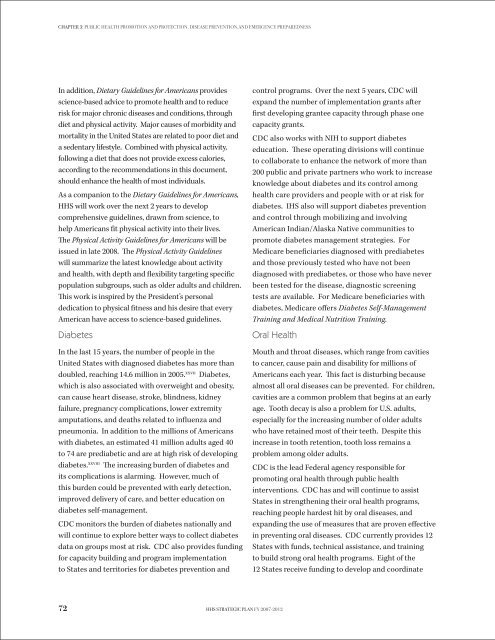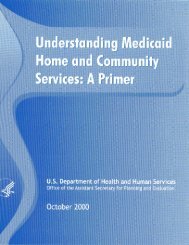STRATEGIC PLAN - ASPE - U.S. Department of Health and Human ...
STRATEGIC PLAN - ASPE - U.S. Department of Health and Human ...
STRATEGIC PLAN - ASPE - U.S. Department of Health and Human ...
Create successful ePaper yourself
Turn your PDF publications into a flip-book with our unique Google optimized e-Paper software.
CHAPTER 3: Public <strong>Health</strong> Promotion <strong>and</strong> Protection, Disease Prevention,<strong>and</strong> Emergency PreparednessIn addition, Dietary Guidelines for Americans providesscience-based advice to promote health <strong>and</strong> to reducerisk for major chronic diseases <strong>and</strong> conditions, throughdiet <strong>and</strong> physical activity. Major causes <strong>of</strong> morbidity <strong>and</strong>mortality in the United States are related to poor diet <strong>and</strong>a sedentary lifestyle. Combined with physical activity,following a diet that does not provide excess calories,according to the recommendations in this document,should enhance the health <strong>of</strong> most individuals.As a companion to the Dietary Guidelines for Americans,HHS will work over the next 2 years to developcomprehensive guidelines, drawn from science, tohelp Americans fit physical activity into their lives.The Physical Activity Guidelines for Americans will beissued in late 2008. The Physical Activity Guidelineswill summarize the latest knowledge about activity<strong>and</strong> health, with depth <strong>and</strong> flexibility targeting specificpopulation subgroups, such as older adults <strong>and</strong> children.This work is inspired by the President’s personaldedication to physical fitness <strong>and</strong> his desire that everyAmerican have access to science-based guidelines.DiabetesIn the last 15 years, the number <strong>of</strong> people in theUnited States with diagnosed diabetes has more th<strong>and</strong>oubled, reaching 14.6 million in 2005. xxvii Diabetes,which is also associated with overweight <strong>and</strong> obesity,can cause heart disease, stroke, blindness, kidneyfailure, pregnancy complications, lower extremityamputations, <strong>and</strong> deaths related to influenza <strong>and</strong>pneumonia. In addition to the millions <strong>of</strong> Americanswith diabetes, an estimated 41 million adults aged 40to 74 are prediabetic <strong>and</strong> are at high risk <strong>of</strong> developingdiabetes. xxviii The increasing burden <strong>of</strong> diabetes <strong>and</strong>its complications is alarming. However, much <strong>of</strong>this burden could be prevented with early detection,improved delivery <strong>of</strong> care, <strong>and</strong> better education ondiabetes self-management.CDC monitors the burden <strong>of</strong> diabetes nationally <strong>and</strong>will continue to explore better ways to collect diabetesdata on groups most at risk. CDC also provides fundingfor capacity building <strong>and</strong> program implementationto States <strong>and</strong> territories for diabetes prevention <strong>and</strong>control programs. Over the next 5 years, CDC willexp<strong>and</strong> the number <strong>of</strong> implementation grants afterfirst developing grantee capacity through phase onecapacity grants.CDC also works with NIH to support diabeteseducation. These operating divisions will continueto collaborate to enhance the network <strong>of</strong> more than200 public <strong>and</strong> private partners who work to increaseknowledge about diabetes <strong>and</strong> its control amonghealth care providers <strong>and</strong> people with or at risk fordiabetes. IHS also will support diabetes prevention<strong>and</strong> control through mobilizing <strong>and</strong> involvingAmerican Indian/Alaska Native communities topromote diabetes management strategies. ForMedicare beneficiaries diagnosed with prediabetes<strong>and</strong> those previously tested who have not beendiagnosed with prediabetes, or those who have neverbeen tested for the disease, diagnostic screeningtests are available. For Medicare beneficiaries withdiabetes, Medicare <strong>of</strong>fers Diabetes Self-ManagementTraining <strong>and</strong> Medical Nutrition Training.Oral <strong>Health</strong>Mouth <strong>and</strong> throat diseases, which range from cavitiesto cancer, cause pain <strong>and</strong> disability for millions <strong>of</strong>Americans each year. This fact is disturbing becausealmost all oral diseases can be prevented. For children,cavities are a common problem that begins at an earlyage. Tooth decay is also a problem for U.S. adults,especially for the increasing number <strong>of</strong> older adultswho have retained most <strong>of</strong> their teeth. Despite thisincrease in tooth retention, tooth loss remains aproblem among older adults.CDC is the lead Federal agency responsible forpromoting oral health through public healthinterventions. CDC has <strong>and</strong> will continue to assistStates in strengthening their oral health programs,reaching people hardest hit by oral diseases, <strong>and</strong>exp<strong>and</strong>ing the use <strong>of</strong> measures that are proven effectivein preventing oral diseases. CDC currently provides 12States with funds, technical assistance, <strong>and</strong> trainingto build strong oral health programs. Eight <strong>of</strong> the12 States receive funding to develop <strong>and</strong> coordinate72 HHS Strategic Plan FY 2007-2012
















